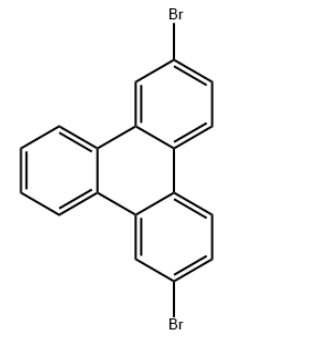2,7-Dibromotriphenylene CAS#: 888041-37-0; ChemWhat Code: 1411604
Identification
| Patent Information | ||
| Patent ID | Title | Publication Date |
| CN108329270 | Organic electroluminescence material containing triphenylene and benzimidazole structure and organic light-emitting device of organic electroluminescence material | 2018 |
| EP2679581 | COMPOUND CONTAINING SUBSTITUTED TRIPHENYLE RING STRUCTURE, AND ORGANIC ELECTROLUMINESCENT ELEMENT | 2014 |
Physical Data
| Appearance | White powder |
| Melting Point, °C | Solvent (Melting Point) |
| 220 – 223 | acetonitrile |
Spectra
| Description (NMR Spectroscopy) | Nucleus (NMR Spectroscopy) | Solvents (NMR Spectroscopy) | Temperature (NMR Spectroscopy), °C | Frequency (NMR Spectroscopy), MHz |
| Chemical shifts | 13C | CDCl3 | 25 | 125.691 |
| Spectrum | 13C | CDCl3 | 25 | 125.691 |
| Chemical shifts | 1H | CDCl3 | 500 | |
| Spectrum | 1H | CDCl3 | 500 |
| Description (IR Spectroscopy) | Solvent (IR Spectroscopy) |
| Bands | NaCl |
Route of Synthesis (ROS)
Route of Synthesis (ROS) of 2,7-Dibromotriphenylene CAS 888041-37-0
| Conditions | Yield |
| With palladium bis[bis(diphenylphosphino)ferrocene] dichloride; anhydrous potassium acetate In 1,4-dioxane for 72h; Inert atmosphere; Reflux; | 89% |
| With palladium (II) [1,1′-bis(diphenylphosphanyl)ferrocene] dichloride; anhydrous potassium acetate In 1,4-dioxane at 85℃; for 12h; Inert atmosphere; | 76% |
| With dichloro(1,1′-bis(diphenylphosphanyl)ferrocene)palladium(II) dichloromethane adduct; anhydrous potassium acetate In 1,4-dioxane at 80℃; for 10h; Molecular sieve; Inert atmosphere; | 70% |
| With dichloro(1,1′-bis(diphenylphosphanyl)ferrocene)palladium(II) dichloromethane adduct; anhydrous potassium acetate In 1,4-dioxane at 80℃; for 10h; Molecular sieve; Inert atmosphere; | 70% |
| Experimental Procedure 5.5 g of the obtained 2,7-dibromotriphenylene,7.9 g of bis (pinacolato) diboron,4.2 g of potassium acetate,50 ml of 1,4-dioxane previously dehydrated with Molecular Sieves 4 A,0.4 g of [1,1′-bis (diphenylphosphino) ferrocene] palladium (II) dichloride-dichloromethane complex (1: 1) was added to a reaction vessel purged with nitrogen and heated,Followed by stirring at 80 ° C. for 10 hours.After cooling to 50 ° C.,150 ml of chloroform was added,And the mixture was stirred for 30 minutes.Insoluble matter was removed by filtration,The crude product was obtained by concentration.The crude product was purified by column chromatography [carrier: silica gel, eluent: ethyl acetate / n-hexane = 1/5 (v / v)],4.8 g (yield: 70%) of a white powder of 2,7-bis (4,4,5,5-tetramethyl- [1,3,2] dioxaborolan-2-yl) triphenylene was obtained. |
Safety and Hazards
| Pictogram(s) |  |
| Signal | Warning |
| GHS Hazard Statements | H315 (100%): Causes skin irritation [Warning Skin corrosion/irritation] H319 (100%): Causes serious eye irritation [Warning Serious eye damage/eye irritation] |
| Precautionary Statement Codes | P264, P264+P265, P280, P302+P352, P305+P351+P338, P321, P332+P317, P337+P317, and P362+P364 (The corresponding statement to each P-code can be found at the GHS Classification page.) |
Other Data
| Transportation | Not dangerous goods |
| Under room temperature away from light | |
| HS Code | |
| Storage | Under room temperature away from light |
| Shelf Life | 2 years |
| Market Price |
| Druglikeness | |
| Lipinski rules component | |
| Molecular Weight | 386.085 |
| logP | 7.416 |
| HBA | 0 |
| HBD | 0 |
| Matching Lipinski Rules | 3 |
| Veber rules component | |
| Polar Surface Area (PSA) | 0 |
| Rotatable Bond (RotB) | 0 |
| Matching Veber Rules | 2 |
| Toxicity/Safety Pharmacology |
| Quantitative Results |
| Use Pattern |
| 2,7-Dibromotriphenylene CAS 888041-37-0 is uesed as an intermediate in organic synthesis. Through further chemical reactions, it can be used to synthesize organic compounds with different structures and properties. The bromine groups can undergo substitution reactions, allowing for the introduction of other functional groups and expanding the compound’s application range. |
Buy Reagent | |
| No reagent supplier? | Send quick inquiry to ChemWhat |
| Want to be listed here as a reagent supplier? (Paid service) | Click here to contact ChemWhat |
Approved Manufacturers | |
| Warshel Chemical Ltd | http://www.warshel.com/ |
| Want to be listed as an approved manufacturer (Requires approvement)? | Please download and fill out this form and send back to [email protected] |
Contact Us for Other Help | |
| Contact us for other information or services | Click here to contact ChemWhat |



